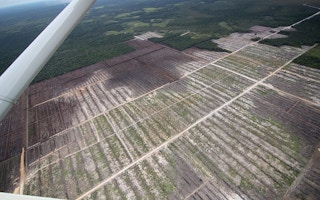In May, the Indonesian government announced that nearly half of the peatlands protected under a 2011 forestry moratorium have actually been damaged or converted.
Last week, the forestry ministry said it would issue a regulation to provide legal status for these areas, which amount to 3.8 million hectares – nearly the size of Puerto Rico.
These peatlands have either burned or been “turned into agriculture, plantations, mines, fish farms and resettlement areas,” San Afri Awang, the ministry’s spatial-planning director, said in Jakarta.
“We cannot allow this. We will settle this. If there’s a violation, we will seek legal recourse.”
Established under an agreement with Norway, the moratorium was hailed as a major breakthrough for conservation. It banned new permits to develop primary forests and peat swamps, which have been widely drained and cleared to make way for palm oil and timber plantations.
“
If you change the status without establishing the forest areas, it’ll end up to be another conflict.
Christian Purba, executive director, Forest Watch Indonesia
In practice, though, enforcement of the policy has been lax, undermined by corruption and poor governance. District heads often hand out plantation permits without the proper approvals from Jakarta, for example.
It was not clear how many of the 3.8 million hectares of peat were intact when the moratorium was established, and how many had already been damaged or converted and were erroneously included in the moratorium map, which was said to still include 4.6 million hectares of intact peatland.
There is also a difference between areas that have been turned into agricultural lands by local people and areas that have been turned into plantations by companies, perhaps with an illegal permit. For the former, the ministry promised to change their status to social forestry, whereas the latter might be met with an investigation and prosecuted.
“There are lots of deforested areas [in the moratorium]. During the previous administration, this [data] was not opened to public,” Awang said.
“We can’t afford to have illegal [areas] being unsolved because it would create serious losses,” he added. “The spirit is to solve these problems not in the context of granting more permits but forest management.”
Greenpeace forest campaigner Yuyun Indradi called on the ministry to disclose the locations of the damaged peatlands, such as in which provinces and concessions they lie.
“The public needs to know to be able to monitor [the situation],” he said.
Christian Purba, executive director of Forest Watch Indonesia, said the ministry should finish legalising its claim to the forest zone to ensure the process goes smoothly.
“If you change the status without establishing the forest areas, it’ll end up to be another conflict. Why not establish the forest areas, and then if it’s deforested then you’ll just exclude them. It’ll be easy to negotiate with people.”
This story was published with permission from Mongabay.com

















